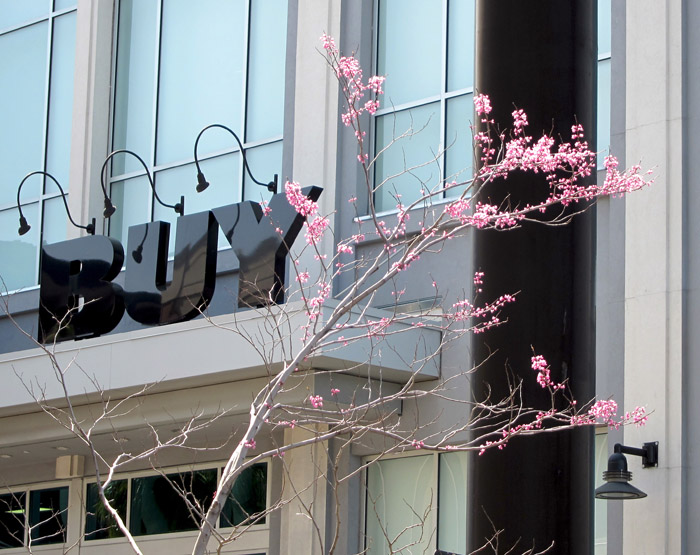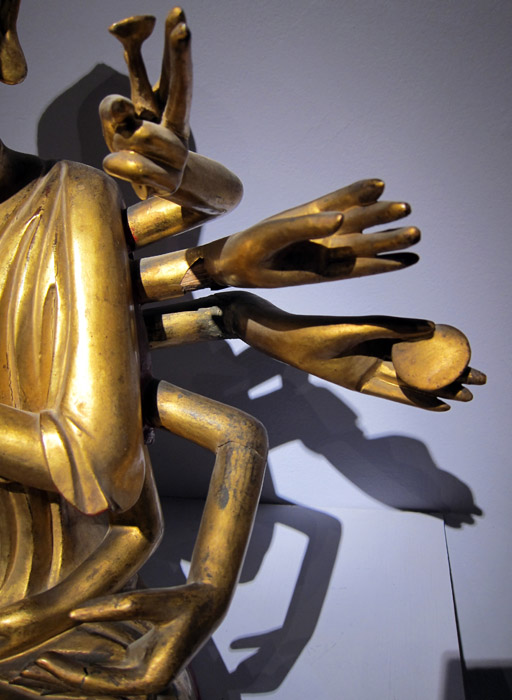
Zombies, Condoms and Shenzhen:
The Surprising Link Between the Undead and the Unborn
by Madeline Ashby

First of all, I’d like to thank the editors of this website for soliciting a contribution from me. It’s not often that someone without an agenda wants to hear from a woman living the kind of life I live. Normally when an outsider asks my opinion, it’s because they secretly hope that I’ll cast aspersions on my husband or our five boys (and counting!). They always ask the clumsiest questions, like how hard it is to keep this acreage going, or whether I believe in science, or if I really think God wanted me to have those episiotomies. I almost never get asked about zombies.
But as a formerly academic woman later called to missionary work in China and moved to enter the Quiverfull lifestyle, and as a fan of Factory Girl and a regular consumer of MieMie fansubs, I feel I have a unique perspective on the fall of Shenzhen and the spread of Lan Caihe. What others have seen a tragedy of systems and infrastructure, I see as the result of humanity’s stubborn and misplaced desire to pervert God’s will. I have seen the segments and read the articles; I have interviewed JieJie and even corresponded with Andrea Dupuis’s former friends. I have done my homework, and I remain just as certain now as I was last year that China s only child policy is to blame for this disaster. If the women of China were free to accept God’s blessings as so many Quiver-minded women and myself have—without the interference of any birth control methods—the spread of Lan Caihe might never have happened. And even if it did, the families of those poor women would enjoy the comfort that a larger number of children can bring in times of such deep anguish. I write these words so that those of you who do not know me as a Quiver-minded blogger will understand my views on this matter from the start. I believe that everything happens for a reason, and that the terrible events in Shenzhen are a message pointing out the error of our ways.
We all fall down…
The line between imagination and reality is often harder to discern than we would like to believe. Since the Enlightenment era’s initial push for rationalism, the dominant global culture has striven to avoid superstition and spiritualism, and to move forward toward “scientific progress.” In our homes, we tell our children that monsters don’t exist, that there is nothing waiting for them under the bed, and that what happens in weekly dramas and on cinema screens is not real and cannot hurt them. “It’s all in your imagination,” we say, as though our imaginations had no impact on reality.
Now, of course, we know differently.
A significant portion of twentieth century mainstream media was devoted to the zombie. From films to novels to comics and manga to video games, artists were consumed (pun intended) by the shambling spectre of the undead. Academics the world over offered differing explanations for this phenomenon: some argued that it was a response to the fears ignited by the arrival of HIV and AIDS, while others claimed that it was simply another envisioning of the apocalypse. Still others offered the idea that the fantasy lay not in surviving the ravages of the onslaught, but in becoming part of the onslaught itself – in transforming into the monster, the ultimate consumer, one tiny droplet in a mindless, ceaseless wave of violence. I asked my husband, a great lover of zombie anything, why he enjoyed them so much, and he told me that since he was a boy, he loved stories of survival. Zombie stories, for him, were stories of self-sufficiency. (It should come as no surprise that he later grew up to own forty acres, farm them himself, and to teach our boys how to operate and maintain their rifles before they were ten years old.)
But while fictional zombies devoured our attention, the reality presented itself with all the banality of yet another mood or social anxiety disorder. The statistical phenomenon that led Andrea Dupuis to discover the disease was more social than medical: a sharp rise in the number of accidental and self-inflicted deaths of women over forty but under sixty in the Shenzhen region, and a steady increase in the rate of accidental deaths among younger women in their late teens and early twenties, coupled with a corresponding lack of similar deaths among men of the same age groups in the same region.
Like many people, I was drawn to the story of Andrea Dupuis after her diaries were leaked online. I considered them an important historical document and immersed myself in their pages. Reading them in full, rather than relying on digests of the most salacious details offered by the mainstream media, has given me a deeper understanding of this determined but troubled woman. In fact, for reason that I will clarify later, I saw a great deal of myself in her. Long before the events that defined her final days, Andrea Dupuis commonly referred to herself as “a heartless bitch.” At age ten, she received a carbon heart. Her eventual decision to become a doctor followed a sickly and isolated childhood. From tests taken during the second trimester of pregnancy, Andrea’s mother learned that the child would have a high likelihood of polycystic ovarian syndrome (CPOS), a pre-disposition to social anxiety, and a potentially fatal defect in her heart. Like so many misguided mothers, she considered termination. But the Lord had other plans, and thankfully Andrea’s mother listened to them. Andrea often wrote about this decision in her diary, after learning the truth from a post-mortem data-dump of her mother’s clouded files. (She thought, as so many troubled people do, that her mother had made a mistake.) Years later, her fellow residents at University Hospital in Ann Arbor later called her “Delta City Dupuis.” When I asked them about her, they told me stories of her showing young patients the scars across her chest.
Andrea related better to these patients than to her own classmates. She saw her time with them as an opportunity to reclaim a childhood she’d never enjoyed, a childhood filled with an endless competition for scholarships to enter chartered and private academies her mother could never afford. She chronicled her pursuit of these honours in her diary with short, efficient entries that nevertheless spared time for the potential meaning of an arch in a teacher’s eyebrow. Reading these entries reminded me of my own childhood and my parents’ insistence on academic excellence. Until my early twenties, I thought that my teachers’ estimation of me as a student translated into my value as a person. This thinking led me down a path of deep dread. I felt as though I were constantly chasing at phantoms in the form of an A or a 4.0. It wasn’t until my graduate school suicide attempt that I saw what I had been doing to myself. Andrea made a similar attempt during the winter of her sophomore year of college. I chose God over drugs or books, but Andrea studied psychiatry to better understand her condition. Coincidentally, we both wound up in China. I followed my mission to that land to share my faith, distribute books and minister to the poor; Andrea applied to complete her residency as an assistant to a factory physician in Shenzhen. Given her history, it was only natural that she began investigating the suicides first.
Andrea documented her research with the same attention to detail that she brought to her diaries. In the Shenzhen suicides, she recognized the anger and isolation that marked her own life. Among these women, abrupt shifts in mood and temperament were common due to the change in their hormonal balances. These shifts resembled the hormonal rollercoaster that Andrea rode as a PCOS patient. Convinced that these women did not have to die, and believing herself a witness to the birth of a new social anxiety disorder, Andrea hired a translator and research assistant named Dàdǎn Yìrén, and started learning everything she could about her new home.
Shenzhen was the headquarters of several of China’s most profitable technology companies, and the site of the national stock exchange. From tube socks to transistors, Shenzhen was responsible for their worldwide dissemination, and for the trade brokerages that made that dissemination possible. From this perspective, the city was a crown jewel. For this reason (and many others, I’m sure, that are up to more experienced academics than me to understand), both the Shenzhen municipal authorities and the Chinese government as a whole were loath to admit that there was a flaw buried deep in its glittering heart.
Before she died, Andrea Dupuis knew these facts:

In industrial environments, work can be hazardous, and young employees are often the first to be injured simply because they know no better. For years, this was the line that major companies headquartered in the Park gave to the rural families waiting at home for their daughters, when sending their final paystubs. But in part due to the greater expansion of internet connectivity, and perhaps in part the greater awareness following the cover-up of shoddy school design and corrupt building contracts leading to the collapse of several schools following the 2008 Sichuan earthquake, parents began connecting the dots. They started asking questions. They wondered about the stories their daughters told, the ones they had initially discounted, about “mean” older women, women they thought of as bullies or spinsters or bitter old crones, who were simply enduring a change and taking it out on the younger employees. Why were there so many accidents, so suddenly? Why were none of the older women dying? As a humble resident, Andrea Dupuis found herself fielding these questions. Rather than answer them with information she did not yet possess, she promptly asked permission to have the bodies autopsied.
Lan-Caihe is a degenerative brain disorder that, like Alzheimer’s, erodes the myelin sheaths around the neural synapses of the insular cortex. However, unlike Alzheimer’s or its pre-cursor, dementia, Lan-Caihe blooms first in the judgement centres of the brain, specifically the anterior insula, which is crucial to “simulating” or “predicting” outcomes of a particular situation, as well as generating reactions of empathy by hosting mirror neurons in other brain centres that process feelings of pain and disgust.
Sufferers are seemingly incapable of accurate threat assessment, seeing subtle shifts in posture or tones of voice as indicative of another person’s violent intent. They react to the slightest provocation with intense fear or rage, their brains having short-circuited their ability to understand the difference between the jostling of a crowded subway car and a group assault. As the disease advances, random explosions of uncontrollable violence are the result. Patients grow increasingly dissociated from reality, often remembering threats and insults that never happened despite being presented with evidence to the contrary in the form of security footage and other documentation. In the final phase of the disease, patients enter “zombie mode,” suffering a complete break with reality that often causes accidental death or requires lethal intervention from police or other authorities.
Over a long weekend, while they finalized their report for Nature at her apartment, Dupuis entered what we now recognize as the late stages of Lan-Caihe. How she acquired it remains a mystery, although forensic pathologists and epidemiologists suspect that Dupuis handled brain tissue improperly, infecting herself during one of the autopsies she pleaded with patients’ families to perform. Others have theorized that constant exposure to the toxic chemicals floating freely through the factory where Dupuis and her fellow patients worked contributed to their tissue degeneration. Data gleaned from her browsing history indicate that during the early hours of Sunday morning, Dupuis became convinced that her assistant Yìrén intended to rape her. She then severed the main hose connecting her floor’s washer unit to the wall of her apartment, woke Yìrén and asked his help fixing it. She struck him twice over the head with a heavy flashlight, and then locked him in the laundry room with quick-drying proto-epoxy.
Afterward, she wandered to the train station, where she bullied a human attendant into retrieving her pass number. The attendant flagged her face for surveillance, and Hong Kong botflies followed her when she disembarked. Without money in 102 ° heat and 90% humidity, Dupuis shoplifted a bottle of Oi Ocha, and the flies reported her to the nearest precinct. When police officers attempted to subdue her, she threw the empty bottle at them. They tazed her. This in turn spurred a malfunction in her heart, which needed a firmware upgrade whose EULA Dupuis strenuously objected to upon its initial release, and refused to download. She died before reaching the nearest hospital. Back home, her former classmates joked that the cause of death was “severe arrest.”

Factory Girl
Unbeknownst to the rest of the world, Andrea Dupuis had carefully documented the effects of one the most insidious brain disorders in human history. However, it took the efforts of a very young cast of Chinese television and pop idols, an international crew of twenty fansubbers, and thousands of grey-legal downloads before this could ever be known. In particular, the efforts of MieMieSubs, a fansubbing circle whose leader “JieJie” is located in Markham, Ontario, brought attention to the situation and to the story of Andrea Dupuis. I have followed MieMieSubs since returning from my own mission trip to China, where I first became enamoured of their televised costume dramas. I now download these dramas for my boys, in the hopes of improving their reading skills (the subtitles can be a rewarding challenge, for the little ones!) and interesting them in history. When JieJie first started timelining her reactions to Andrea’s diary, I noticed and told her that I was reading them, too. We started reading together, sharing our observations and shaking our heads at the tragedy of her life. When I told her about the opportunity to write this post, she agreed to let me visit and interview her more formally. (It’s a three-hour drive, and I had to bring my two youngest. JieJie was a most gracious host and allowed them to read some of her old books from when she was younger, even running the titles by me first.) It was the first formal interview she had answered since entering the history of Lan-Caihe. She timelines answers to other questions. She persisted in doing so while we talked.
Andrea and JieJie could not be more different. While Andrea struggled to achieve recognition in school, JieJie – still in high school, and fifteen at the time she founded MieMieSubs – exerts herself only in areas where she cannot be graded. The “fan-love” reputation scores under her online pseudonym are astronomically high, but the provincially-sanctioned “benchmarks” that accompany her official student profile are appallingly low. (She scores 1.5 maple leaves out of a possible five. When I asked her if I could publish that fact, she looked up briefly from her editing suite and said, “Huh? What? Sure.”) At first, this bothered her parents. Then JieJie threatened to call the copy cops on her grandfather, a man with a long history of pirating media for profit, who also happens to hold the mortgage on their home. The nagging ceased. I have since met JieJie’s grandfather, a man with an affection for dried cuttlefish. (He offered me some, and although I only took it out of politeness, I soon asked for his recipe.) When I told him about her threat, he laughed and said that this was one of their oldest and most favourite games. “Don’t tell her folks, though,” he said. “They’ve got a real pickle up their a__ about that kind of thing.”
When she heard that Factory Girl, a Hong-Kong produced weekly drama would film on location in the Shensen Industrial Park, JieJie did the fannish thing and began collecting information about the Park. There, she found the mention of Andrea Dupuis. In a development that mirrored Andrea’s own desire to help the women she identified with, JieJie found she had a strong motive for learning the truth about Andrea: the two women shared a heart. Although JieJie uses a later model, they both would have logged into the same page and partcipated in the same comms when downloading firmware for their organs. In an indirect way, JieJie credits her surgery with what she admits is “slackerdom.”
“I just decided to enjoy my life, and do the things I actually cared about,” she told me. “I mean I died on the table. Like, twice. So my grades? F______ b_______. So not important.”
When shooting started, the cast of Factory Girl immediately began tweeting their reactions to their new environment. Although they kept their messages polite and hopeful, they joked that it might be dangerous based on the experiences described to them by the series’ new extras. But JieJie and the subbing circle knew that there was real reason to worry. When they began digging more deeply into the histories of the Park, they learned the stories of the families waiting at home for daughters who would never return. Then they did what fans do best: they chattered. Fans who worried that their favourite actors were unsafe began contacting the entertainment agencies that funded the program. (I was one of them.) We pleaded for the location shoots to be moved to other sites with better track records.
The trouble, we soon discovered, was that there weren’t any.
Those heady days are still a blur, for me. It was not unlike the birth of a new child: the sleeplessness, the discoveries, the sense that every single second that passed would forever change the situation. But this time, my baby was growing up far away from me, and I had to check my timeline to watch his every development. My own children complained. My husband took me aside, when we were late for church because of my constant checking. I tried to explain what this meant to me, how I saw myself in Andrea Dupuis, how it was vitally important that I learn everything I could about her and share that knowledge with other women in my community. At the time, we weren’t sure what density of physical proximity helped bring about Lan-Caihe. I told my husband that Quiver-minded family farms, where groups of sixty can sometimes live together on the last great patches of acreage in our country, might be in danger of the disease. At that, he relented.
Now, I must confess that this was a ruse on my part. What I really wanted was to take advantage of the opportunity to observe history. Perhaps this was nothing more than simple pride, assuming that I could somehow influence events, or that my testimony to them would be counted as prominent or relevant. But at the moment I felt as though I had been swept up by a tide of unseen voices, a heavenly chorus shouting into the night for truth. In that moment I was not a wife or mother or homeschool teacher or gardener or crafter. I was no longer the woman who shows off her prize pickles or her homemade yogurt or who hums hymns as she folds laundry. I was one among many. I felt as Christian soldiers should, though (I’m ashamed to admit) more committed to this mission than I had been to my earlier one in China. I realize that is a failing of a certain kind, but at the time all I wanted was to evangelize and spread the gospel of Shenzhen. I wanted people to know. I wanted something to be done. In the face of systemic madness, all I could do was write.

The Law of Unintended Consequences
Once the danger became plain, Shenzhen collapsed entirely. A few women walked off the job. Some managers fled. Factory populations diminished. Slowly and quietly, corporate headquarters began re-locating. Like the zombies that had frightened everyone away, Shenzhen shambled, dead but theoretically functional, going through the motions of continuing an economy which had already left it behind to rot. The abandonment of Shenzhen and the Industrial Park has made the failure of the Pruitt-Igoe and Cabrini-Green projects look like dress rehearsals. Skyscrapers, some of them 400 stories high, are now hollow. The trains, once thickly packed with people, sit rusting on decaying tracks, some of them already flayed for their valuable scrap metal by the same rural youngsters that the city once meant to save. The world has moved on. With it, so has industry.
Shenzhen’s former industries were numerous, and their concentration within a single community made their products cheaper and more easily accessible along traditional container-ship routes. In some cases (such as the textile market), production moved elsewhere rather easily. In other cases, high-tech industries saw the advantage of moving outside the Park and starting somewhere new. Apple, for instance, has started “orchards” for the production of their products in China, where the populations never rise above a certain number and the gender and age groups are more equally mixed than they were in the old Foxconn factories.
But in the nitrile and latex industries, the shift has come more slowly. I view this development with hope. Latex, a product derived from the both petrochemicals and the secretions of rubber trees farmed in Southeast Asia, is the primary ingredient in two important health maintenance devices: sterile surgical gloves, and condoms. As of the beginning of the twenty-first century, Shenzhen was a major hub of condom and latex glove production, with half of all condoms coming from the Park’s manufacturers. When Shenzhen fell, so did the supply, and prices rose. This rise in prices has forced many to re-think the thinking around condoms and birth control in general. More people are seeing children as what they are: supernumeraries of fate dancing onto the family stage. These new little blessings are now delivered by doctors and nurses with steri-slime on their hands, not nitrile or latex gloves.
The climbing birthrate has become a talking point among liberals who believe that putting an end to the horrific conditions in these factories is somehow an act of social injustice. But what they fail to recognize is that the production of condoms and other birth control devices, much of which was done in China, further perpetuated the oppression of Chinese women who desperately wanted more children but who feared punishment by their government for having them. The womb is God’s to open or close, not the government’s. Why is this still so difficult for us to understand? Why haven’t we learned our place? What happened in Shenzhen is a sign. As a result of the only child policy, village mothers had to send their daughters off to dangerous factories to work for long hours for employers with no interest in their safety. Without brothers or sisters to shoulder the burden of caring for family elders, these girls had to stay and suffer while Lan-Caihe ate their co-workers alive. Is that justice?
“I think the only child thing is f______ stupid,” JieJie said, when I asked her this question. “What business is it of anybody’s how many kids you have?” She shrugged. “Weren’t people allergic to it? Latex, I mean. Weren’t they allergic? It’s probably good that it’s gone. Like peanuts. I can’t believe they used to sell peanuts everywhere. F______ irresponsible.”
I asked JieJie if she had any desire to visit Shenzhen, but she shook her head. “I want to edit MV’s and commercials,” she said. “My embeds and my augments are really smooth, and the Korean studios pay you to do that for product placement. I’m spending a ton of fan-love to get my portfolio and cover letter and everything translated really good, so I can send them out and start working.”
When speaking about Andrea Dupuis, she paused before giving a quieter answer: “I found out that she watched two of the dramas my team worked on. I like to think that we had the same theme songs stuck in our heads.”
Increasingly, it seems as though history is being made not by the people in our capitols or great cities, but by the invisible and anonymous online, those people who find their passion and hear the call to action from their friends and not their leaders. As a homeschool teacher, I often wonder how the more mainstream texts will depict these events and the people who brought them about. Where will our voices be, in the story of Lan-Caihe? Will posts like these be lost in the next tsunami or splash, when the server lilies overturn? What about all the little messages that brought this about: the conversations and comments, the tweets and nudges? Will they come out in the wash of propaganda from Beijing? Will my sons ever know this story the way that I know it?
From where I sit, I can see my boys outside at the split-rail. Their father is doing rifle drills with them, today. He says they should be ready, because you never know. But what I fear most isn’t not knowing: it’s that someone somewhere knows, and is doing nothing.
About the Author

Madeline Ashby is a science fiction writer, blogger for Tor.com, and a student of the Strategic Foresight & Innovation program at the Ontario College of Art and Design. Her fiction has been published at in Nature, Escape Pod, Tesseracts, and Shine.
Post a comment on this story!